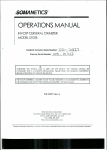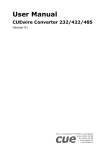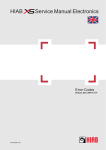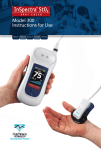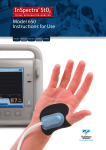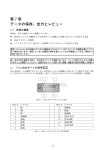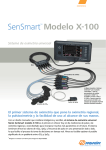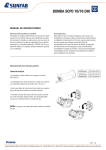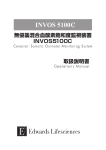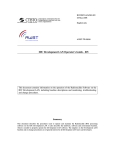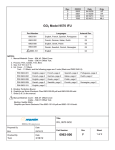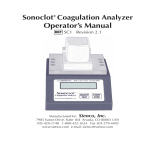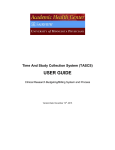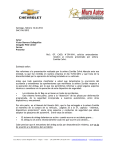Download Model 7600 Regional Oximeter System
Transcript
regional oximetry Model 7600 • Sensors that minimize signal loss • Superior accuracy and consistency Model 7600 Regional Oximeter System • Three-wavelength trending or four-wavelength absolute sensors that are tolerant of ambient light • Portable • No maintenance See the Difference Nonin Medical: Innovative Leaders in Noninvasive Physiological Monitoring Nonin Medical is a technology-driven company and a global leader in developing noninvasive medical monitoring solutions that improve the quality of people’s lives and enable them to live their lives to the fullest. We do this by developing low-cost, high-quality, easy-to-use technologies that empower clinicians to make better decisions and individuals to proactively manage their health. References Wolman RL et al; Stroke 1999; 30:514. Nonin Medical, Inc. Nonin Medical AB Mibrandt EB et al; Crit Care Med. 2008 Sep;36:2504. 13700 1st Avenue North Plymouth, MN ¡ 55441-5443 ¡ USA P +1.763.553.9968 TF 800.356.8874 Fibervägen 2, 82450 Hudiksvall, Sweden P +46 650 401500 F +46 650 401514 E [email protected] Cardiac Study on file at Nonin Medical. viii Repeatability Study on file at Nonin Medical. ix Exercise Comparison Study on file at Nonin Medical. x Cardiovascular Surgery Study on file at Nonin Medical. xi i ii iii iv Dasta JF; Crit Care Med. 2005 Jun;33:1266. Goldman SM et al; Sem Cardiothorac Vasc Anesth 2006; 10:171. Salazar JD et al; Ann Thorac Surg 2001;72:1195. v xii Fischer, Gregory W. Recent Advances in Application of Cerebral Oximetry in Adult Cardiovascular Surgery, Seminars in Cardiothoracic and Vascular Anesthesia, March 2008. xiii Cohn, T. The Cost of Biomedical Repair and Maintenance: Results of a Survey, Med Instrum, 1982 Sep-Oct;16(5):269-71. Murkin JM et al; Anesth Analg 2007; 104:51. vi Chen PhD, B, Fore-Sight Cerebral Oximetry Clinical Data Presentation DHCA Study, Mount Sinai Medical Center, Cerebral Oximetry Monitoring of Patients Undergoing Elective Thoracic Aortic Surgery with DHCA and SCP (15 Subjects), September, 2008. vii QATR1587 Calibration and Validation of the Non-Invasive Regional Oximeter System xiv Data on file at Nonin Medical, Inc. Plymouth, MN xv ©2011 Nonin Medical, Inc. All trademarks are the property of Nonin Medical, Inc. unless otherwise noted. INVOS® System is a registered trademark of Somanetics Corporation. FORE-SIGHT® is a registered trademark of CAS Medical Systems, Inc. InSpectra™ is a registered trademark of Hutchinson Technology Incorporated. 8095-001-01 F +1.763.577.5521 E [email protected] www.noninequanox.com Improved patient outcomes: Equanox Classic™ Sensor rSO2 During Open Heart Cardiac Bypass Surgery: Stable and Responsive Measure of Patient Status Baseline (prior to induction) Intubation complete Aortic cannulations Initiation of cpb Off cpb A direct correlation to significantly reduced costs EQUANOX Cerebral Injury Protection Results in Improved Outcomes and Reduced Costs According to multi-disciplinary research, the annual cost of Type 1 and Type 2 cerebral injury for a hospital completing 500 open-heart cases per year can reach over $10,000,000.viii,ix,x Studies show that noninvasive near-infrared technology (NIRS) is highly effective in detecting cerebral oxygen deficiencies. Stroke alone can be reduced 50% – 75%, resulting in significant savings on treatment costs.v,xi The cost to treat a severe, Type I, cerebral injury patient (left) and a Type II patient (right) are shown in the above chart. Note: The cost to treat a stroke patient increases substantially if ventilation is required.xii 67% Type of cerebral oxygen saturation (rSO2) interventions in the intervention groupv 62% Protect Your Patients and Facility from Costly Peri-Operative Cerebral Injury 50% 48% Continuous cerebral oxygenation monitoring throughout the peri-operative cardiac surgery period is proven to reduce the rate of stroke. 43% 17% Raise Pump Flow Raise MAP Normalize PaCO2 Deepen Anesthesia 2 Increase FiO2 Pulsatile Perfusion 3 Consistency = Light Detection Light Source Nonin Medical superior signal processing Light Source 3) Third Generation Two Emitters / Two Receivers 1) First Generation 2) Second Generation One Emitter / One Receiver Nonin One Emitter / Two Receivers (Examples include Hutchinson Technology InSpectra ) ™ (Examples include CASMED FORE-SIGHT® and Somanetics INVOS®) EQUANOX Technology Used in Cerebral Applications Unique to the EQUANOX technology, dual emitters alternately create pairs of reflected light paths through surface tissue to the shallow receiver and through the cerebral cortex to the far receiver. The system algorithm first uses the dual emitter architecture to remove surface effects that modulate light amplitude and then uses the shallow path to remove the surface tissue components from the deep path signals—resulting in a cerebral cortex measurement that is unaffected by intervening tissue or surface effects. 4 5 It starts with EQUANOX sensor technology ™ • Ambient light tolerancei – No need to cover the sensor with shields • Thin cables with optimized placement – Thin cables attached at the center of the sensor make it easy to place sensors evenly • Pliable foam material – Prevents sensor lifting for maximized performance • Interference tolerant – Shielded for use in a wide variety of settings X EQUANO Advance TM 6 7 Accurate in a wide range of patients in a wide range of settings Proven Accuracy for Appropriate Clinical Action For real-time cerebral injury protection, the EQUANOX 7600 System delivers stable, industry-leading accurate rSO2 measurements throughout the peri-operative period. Advanced signal processing and superior sensor architecture eliminates interference for consistently accurate measurements you can rely on. • Improved Outcomes – Detect dangerous drops in regional oxygenation as they happen. Dependable readings immediately alert the clinical team to a potential need for intervention. • Time-Saving Reliability – With proven repeatability of ±2 digits, there is no need to capture a new baseline after sensors have been moved or changed—resulting in maximum convenience and time savings.ii 8 The powerful, simple design of Nonin EQUANOX technology generates stable, responsive signal processing to inspire Communications circuitry reliably sends secure digital data to the monitor and isolates patient for safety confidence that rSO2 values reflect true patient physiology. Shielded circuitry avoids environmental interference to ensure stability Analog circuitry amplifies and refines sensor signals Digital microcontroller with advanced signal processing provides lightning-fast response 9 The best just got better Choose from the EQUANOX Classic™ three-wavelength sensor or the EQUANOX Advance™ four-wavelength sensor Conventional NIRS Trending Variabilityxv Cerebral patient monitoring, using Equanox Classic™ Sensor rSO2 readings with the three-wavelength line rSO2 Clinical Range (%) 70 65 25% of Resting Baselinev 62 55 53 If rSO2 saturation falls 25 percent below baseline, then a clinician may consider intervention justified.v 49 EQUANOX Classic Sensor, Model 8000CA with DB9 connector ™ Percent of Total Patients 82 73 A Hypoxia Zone Adequate Perfusion Compared to traditional NIRS trending 50 technology, EQUANOX Advance is absolute, 40 providing enhanced accuracy in rSO2 30 measurements on all patients, regardless of 20 weight or skin colorxiv…no more guessing 10 or over-treatment if patients do not read, or read inaccurately. In the histograms A and 0 20 40 60 rSO2 Values 80 100 is in graph A and EQUANOX Advance is in graph B. Graph B represents the general Limited O2 Reserves alignment of data observations of both EQUANOX Advance rSO2 Values Aligned with SavO2i Cerebral patient monitoring, using Equanox Advance Sensor rSO2 readings with the four-wavelength line rSO2 Clinical Range (%) B ™ % rSO2 Potential for limited oxygen reserves 100 60% EQUANOX Advance™ Sensor, Model 8004CA with mini-connector Adequate perfusion • Absolute %rSO2 is a reliable indicator of available oxygen reservesvi •Healthy patients have a resting baseline %rSO2 of 60 or higher vi •If %rSO2 falls below 60 percent, a patient is potentially functioning with limited oxygen reserves; at this point a clinician may consider intervention justifiedvi EQUANOX Advance-reported rSO2 values (blue) and invasive blood-draw-derived 80 Percent of Observations in Each Decade 0 B (at left), conventional trending technology SavO2 values (orange) at room air.xiv,xv 70% 70% 70 60 50 rSO2 40 SavO2 30 22% 20 10 9% 13% 18% 0 60% - 70% 70% - 80% 80% - 90% Date rounded up, percentages add up to greater than 100%. rSO2 and SavO2 Decades (%) 10 11 Available options See the difference Nonin Medical® Model 7600 Regional Oximeter System Actual size: 305 mm (12.0”) W x 180 mm (7.2”) H x 130 mm (5.0”) D Somanetics® INVOS® System CASMED® FORE-SIGHT® Oximeter Channels and Wavelengths Max Channels 4 4 2 Wavelengths 3-4 2 4 2 lbs. / 900 g. 14 lbs. / 6.85 kg. 14 lbs. / 6.85 kg. 3 hour 20 minutes 1.5 hour Lithium ion Lead-acid Lead-acid 2.5 hours 24 hours 16.5 hours Yes No (requires signal strength detection) No (requires setup before sensor reading) 0-100% 15-95% 0-99% 1.5 seconds 5-6 seconds 2 seconds Cerebral indications Trending, Absolute Trending only Absolute Somatic indications Yes* Yes Yes Tolerant to ambient light Yes No No No periodic maintenance required† Fuses, CPU Maintenance, Battery Replacement (estimated 7.4% of acquisition cost)xiii Fuses, Fan Cleanings, Battery Replacement (estimated 7.4% of acquisition cost)xiii No Yes Yes 3 years 12 months 12 months Monitor Specifics Weight Battery life Battery designs Battery re-charge times Instant reading Operational Parameters Range of SpO2 Oximetry Pod: DB9 connector (trending) EQUANOX Classic three-wavelength sensor ™ + + Display Monitor: Displays up to 4 channels of rSO2 measurement 12 + Trunk Cable: Choice of 1-channel, 2-channel or 4-channel Sensor Specifics Maintenance or or Refresh rate Annual required maintenance costs Weekly cleanings + Warranty Comparisons Monitor warranty Oximetry Pod: mini connector (absolute) EQUANOX Advance four-wavelength sensor ™ † EQUANOX Model 7600 User’s Manual *For use with the Model 8004CA Sensor Only 13 Nonin Medical The Inventor of Fingertip Pulse Oximetry Nonin Medical, Inc. invented fingertip pulse oximetry with its introduction of the Onyx® 9500. With 25 years of signal processing and sensor design expertise using nearinfrared spectroscopy (NIRS), Nonin’s pulse oximetry and regional oximetry systems enable clinicians to quickly and accurately monitor patients in the widest range of settings—even in the presence of low perfusion, motion and other challenging conditions. The Onyx® II, Model 9560, is the world’s first Continua™ certified fingertip pulse oximeter with Bluetooth® wireless technology. 14 and an Innovator in NIRS-based Signal Processing Nonin Medical was founded in 1986 by four engineers who launched the company from a basement. One of those engineers, Philip Isaacson, is Nonin’s Chief Technology Officer today. The company’s clinically proven PureSAT® technology—which provides signal processing speed, stability, and the ability to uniquely filter out artifact interference—provides confidence to millions of clinicians worldwide and remains the hallmark of a Nonin oximeter today. Nonin Medical Founder and Chief Technology Officer, Philip Isaacson Trust icians’ 25 Years of Clin Nonin Medical derives its name from the founders’ commitment to developing noninvasive physiological monitoring solutions that simplify healthcare delivery, reduce costs and enable people to live their lives to the fullest. Nonin Medical’s Onyx® II, Model 9560 fingertip pulse oximeter with Bluetooth® wireless technology (circled, above) monitors the vital signs of miner Jorge Galleguillos during his dramatic rescue from a collapsed Chilean copper mine. Nonin Medical invented the world’s frist fingertip and wireless fingertip pulse oximeters. Photo: Courtesy of CNN 15









